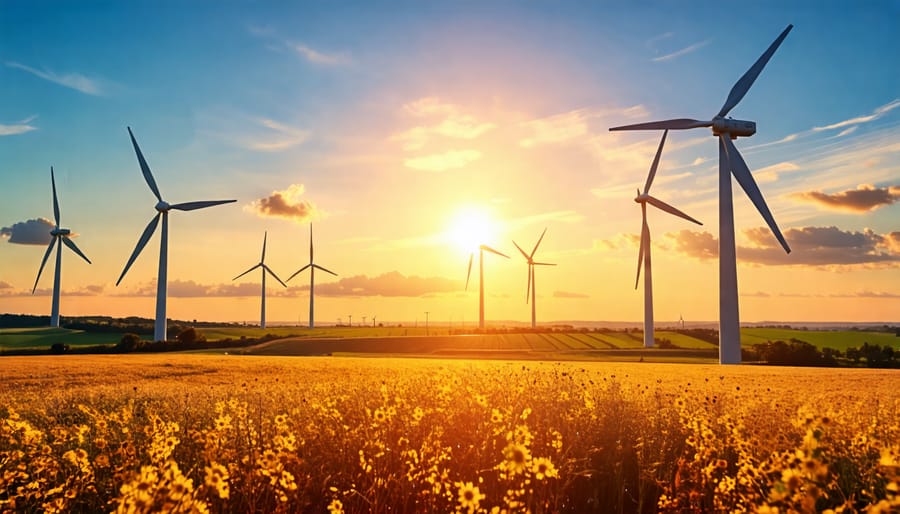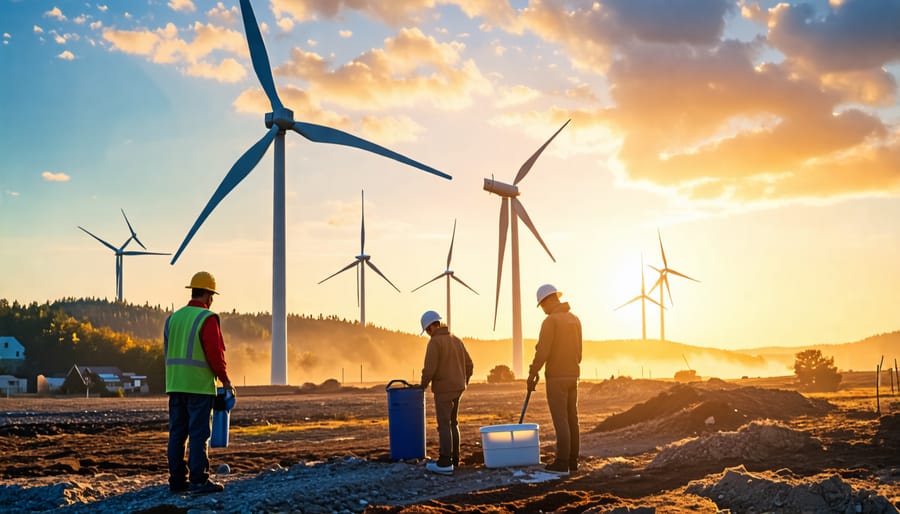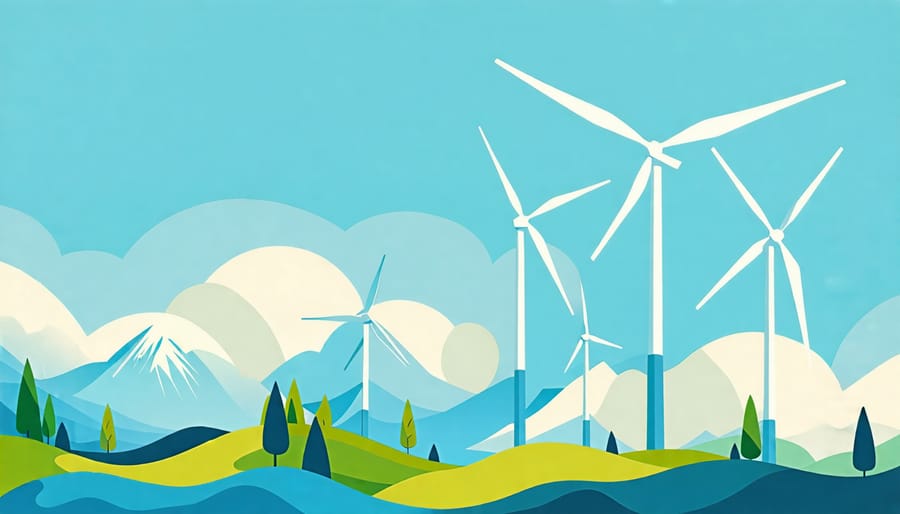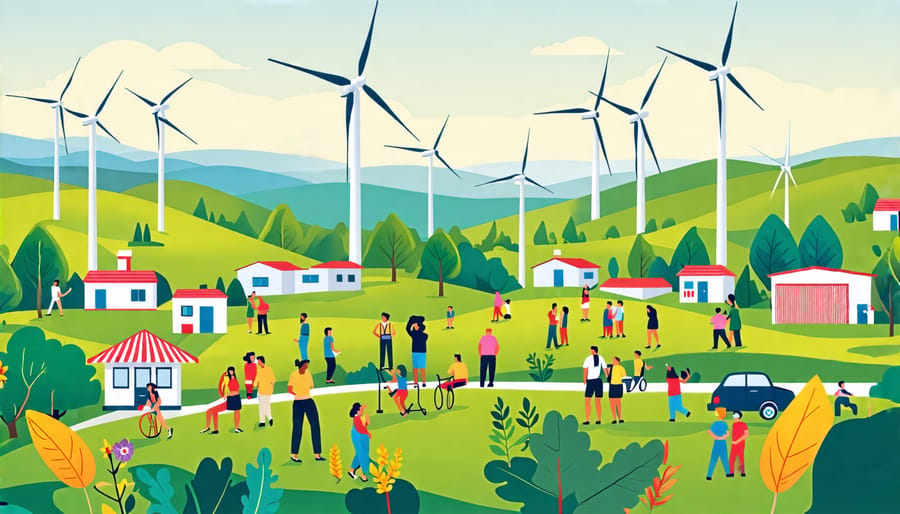Investigate the economic developments driven by wind power initiatives, focusing on job creation, local business growth, and increased tax revenues in communities. Examine environmental benefits, such as the reduction of carbon emissions and conservation of local ecosystems, which positively impact community health and sustainability. Evaluate social dynamics, including community engagement strategies and public opinion, to enhance project success and acceptance. Analyze real-life case studies of wind projects, highlighting lessons learned and community transformation stories, to illustrate the profound impact of wind energy.
The Rise of Wind Power
Technological Advancements
Recent technological advancements have catalyzed the growth of wind power, making it a cornerstone of sustainable energy solutions. One significant innovation is the development of larger, more efficient turbines. These giants not only capture more wind but also reduce the cost of energy production, making wind farms a more attractive investment. The introduction of smart technology, such as predictive maintenance and real-time monitoring systems, has enhanced the reliability and lifespan of wind turbines, reducing operational costs and increasing energy output.
Floating wind farms represent another breakthrough, expanding wind energy’s reach to deeper waters that were previously inaccessible. This technology has opened up vast new areas for development, significantly bolstering the global wind energy capacity. Additionally, improvements in energy storage, including advanced battery systems, help address the intermittent nature of wind, ensuring a steady power supply.
These technological strides not only propel wind power forward but also empower communities, offering sustainable economic growth and paving the way towards a cleaner future.

Global Expansion Trends
In recent years, wind power has been soaring across the globe, transforming the energy landscape with its clean and renewable promise. A major driving force behind this trend is the urgent need to combat climate change by reducing reliance on fossil fuels and decreasing greenhouse gas emissions. Countries worldwide are adopting wind energy at unprecedented rates, encouraged by technological advancements that have made wind turbines more efficient and cost-effective than ever before. In places like Denmark, where wind power already covers over 40% of electricity needs, the success story is a testament to its potential. Meanwhile, countries like China and the United States are significantly scaling up their wind energy capacity, propelled by favorable policies and investments aimed at bolstering their sustainable energy portfolios. This global commitment to wind power is not just about technology and economy; it’s also sparking profound social impacts, driving job creation in manufacturing and installation, empowering local communities, and providing cleaner air, thereby enhancing quality of life worldwide.
Economic Impacts on Communities

Job Creation and Opportunities
Wind power projects are a significant driver of job creation and present numerous job opportunities for local communities. The construction, operation, and maintenance of wind farms generate a diverse range of employment positions, from engineers and turbine technicians to environmental consultants and project managers. These jobs often offer competitive salaries and the chance to develop specialized skills within the renewable energy sector.
A notable benefit is the ability of wind power projects to stimulate local economies. For instance, in rural areas where these projects are often based, new jobs can be critical for boosting economic activity. Local businesses further benefit as employees and contractors frequent nearby shops and services, promoting sustained community development.
Additionally, the wind power industry actively invests in training and education initiatives, ensuring residents are well-equipped to take advantage of the emerging opportunities. Programs tailored to skill-building in construction and maintenance, among others, help locals secure long-term employment, support sustainable development, and reduce reliance on fossil fuels.
Case studies from areas like Texas in the United States illustrate how such renewable energy projects can transform economies, offering tangible benefits to those living in their vicinity. This positive social impact underscores the potential of wind energy to power not only homes and businesses but also livelihoods, reinforcing the growing importance of sustainable and local solutions in combating climate change.
Economic Revitalization
Wind power has made significant contributions to economic revitalization in various regions around the world, providing a sustainable boost to local economies. Take, for example, the once-struggling Rust Belt town of Fowler Ridge, Indiana. By welcoming large-scale wind farms, this area witnessed a transformation, generating clean energy and creating hundreds of jobs. The construction and maintenance of these wind farms require a diverse workforce, ranging from engineers and technicians to administrative staff. This influx of employment opportunities has attracted skilled workers and stimulated local businesses, from housing to retail.
Similarly, in the small town of Samsø, Denmark, wind power has completely changed the economic landscape. Once reliant on costly imported energy, Samsø now produces surplus energy, which it sells back to the grid. This shift not only made the island energy independent but also provided stable revenue streams that fund local development initiatives, improving infrastructure and public services. As a result, tourism on the island has seen an uptick, with visitors drawn to its pioneering renewable energy projects.
Through these examples, it’s clear that wind power can be a powerful catalyst for economic growth and rejuvenation, turning disadvantaged areas into thriving communities while promoting a sustainable future.
Environmental and Health Benefits

Reduced Carbon Footprint
Wind power significantly contributes to a reduced carbon footprint, offering a cleaner and more sustainable alternative to traditional fossil fuels. Unlike coal or natural gas plants, wind turbines generate electricity without releasing carbon dioxide, making them a key player in combating climate change. According to experts, one of the primary environmental benefits of wind power is its capacity to displace millions of tons of greenhouse gases annually. This transition not only mitigates air pollution but also helps protect ecosystems that are vulnerable to the effects of climate change. For instance, a wind farm can prevent the emission of roughly 1.2 metric tons of CO2 per megawatt-hour compared to coal. Real-life case studies, such as the successful integration of wind energy in Denmark, demonstrate substantial reductions in national carbon footprints. Such initiatives highlight the optimistic potential of wind energy to foster a more sustainable future, inspiring communities worldwide to embrace renewable energy solutions.
Healthier Communities
Wind power represents a significant stride towards healthier communities by providing clean energy that reduces reliance on fossil fuels, which are major contributors to air pollution and its associated health risks. By cutting down on pollutants like sulfur dioxide, nitrogen oxides, and particulate matter, wind energy minimizes respiratory ailments such as asthma, bronchitis, and other cardiovascular conditions, leading to improved air quality and overall public health. A study of communities near wind farms has shown decreased instances of emergency room visits related to these conditions.
Furthermore, wind power diminishes the emission of greenhouse gases, playing a crucial role in alleviating climate change’s impact on health, such as extreme weather events and the spread of infectious diseases. An inspiring example is Denmark, where wind energy has contributed to a noticeable drop in pollution-related health issues, aligning health benefits with environmental and economic gains. As more regions adopt wind energy, communities everywhere are anticipated to enjoy cleaner air and healthier living conditions.
Social Challenges and Opportunities
Community Acceptance and Opposition
Community acceptance of wind power projects is a multifaceted issue influenced by several factors. One of the key aspects is the perceived economic benefits, such as job creation and increased tax revenue, which can foster local support. Additionally, successful projects often engage communities early in the planning stages, offering transparency and opportunities for public input. For instance, the Danish model of community ownership in renewable projects has set a precedent in strengthening public support by allowing locals to invest and benefit directly from wind energy.
Conversely, opposition may arise from concerns about noise, visual impact, and potential effects on wildlife and local ecosystems. Addressing these issues with rigorous environmental assessments and implementing technologies that minimize noise can help alleviate opposition. Interviews with stakeholders, such as policy-makers and environmental experts, emphasize the importance of ongoing dialogue and adaptive management strategies to balance environmental concerns with the clean energy benefits of wind power. By focusing on these inclusive and transparent approaches, communities can find a harmonious path forward, enhancing acceptance and reducing opposition to wind energy projects.
Engagement and Empowerment
Effective community engagement plays a pivotal role in harnessing the social benefits of wind power projects. When communities are actively involved in the planning and implementation of wind energy initiatives, they not only gain a sense of ownership but also directly benefit from the projects in multiple ways. For instance, consider the case of Samsø Island in Denmark. This community-led project resulted in the island becoming energy self-sufficient, with local residents seeing significant economic benefits from their investment in wind energy.
In Germany, the cooperative model has been especially effective, with residents becoming stakeholders in local wind farms. This model not only shares economic returns but also fosters a stronger community connection, leading to broad support for further sustainable initiatives. In Coober Pedy, Australia, a hybrid renewable energy system that includes wind power has improved local electricity reliability, showcasing how such projects can tackle regional challenges while empowering the community.
Involving communities from the ground up ensures projects meet local needs and concerns, driving positive environmental and social outcomes. Through partnerships, educational programs, and transparent communication, community engagement in wind power projects proves to be a catalyst for empowering change and enhancing the quality of life for local residents.
Real-life Case Studies
In recent years, wind power projects have become powerful catalysts for community transformation, offering a promising glimpse into sustainable energy’s potential to foster economic, environmental, and social benefits. One notable example is the town of Samsø in Denmark. Once reliant on imported fossil fuels, Samsø has transitioned to full energy independence through the installation of wind turbines both onshore and offshore. This shift didn’t just introduce clean energy; it spurred local economic growth by creating jobs in turbine maintenance, ecological tourism, and educational sectors focused on renewable technologies. The community faced initial skepticism regarding turbine noise and visual impact, but through transparent dialogue and offering residents co-ownership possibilities in the projects, stakeholders garnered strong local support.
Crossing the Atlantic to southwest Minnesota, the Buffalo Ridge region showcases another success. This rural area undertook wind energy projects to address economic stagnation. The influx of wind farms revitalized the local economy, generating tax revenue and stimulating infrastructure improvements. Though challenges arose, like reconciling turbine placement with agricultural activities, cooperative strategies were enacted, ensuring minimal disruption to farming while maximizing community involvement and benefit.
In both cases, key lessons include the importance of community engagement, transparency in planning, and sharing financial benefits. These elements ensure that wind power projects are not viewed as intrusive but as collaborative ventures. These studies illustrate wind power’s capacity to empower communities, turning environmental concerns into avenues for shared prosperity and sustainable development. As these projects continue to sprout worldwide, they paint an optimistic future where clean energy not only addresses global challenges but also fortifies local resilience and growth.
Conclusion
Wind power emerges as a pivotal force in reshaping communities, offering a beacon of sustainable progress that aligns seamlessly with the social aspirations of environmentally conscious citizens. By harnessing this renewable resource, communities gain not only a cleaner energy source but also an avenue for economic revitalization. Job creation in wind farm construction, maintenance, and operation injects vitality into local economies, often in regions hard-pressed for sustainable development opportunities. Environmentally, the shift lessens our reliance on fossil fuels, reducing carbon footprints and forging a path toward a more sustainable future. Socially, wind power embodies a collaborative spirit, with projects often engaging local stakeholders to ensure alignment with community priorities and needs. As seen in transformative case studies across the globe, wind energy projects have revitalized areas through improved local services funded by tax revenues. With expert insights affirming its benefits, wind power stands as a transformative agent in communities, promoting a cleaner, more prosperous, and inclusive way forward.





